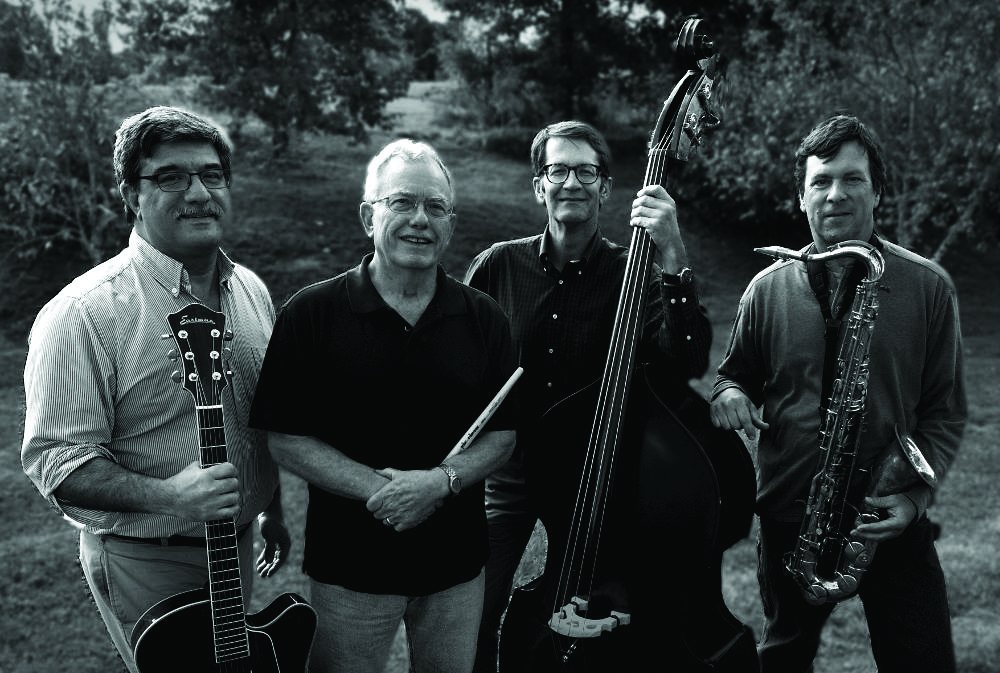

Wolf Hills Jazz Quartet
An encyclopedia definition of jazz will say it is characterized by swing and blue notes (a minor interval where a major is expected), complex chords, call and response vocals, polyrhythms and improvisation. All of which are true, but jazz is also all about freedom and creativity.
Wolf Hills Jazz Quartet (comprised of Tom Peterson, sax; Ernie Braganza, guitar; Joe Pendergast, drums; and Ed Davis) bass chose to play jazz because of their love of that freedom and creativity.
Davis first assembled the group to play for a Glade Springs Art Center benefit in February of 2016. Mike Brown was the guitarist for that gig but agreed to play only that one gig. Braganza was in the audience that night, and Peterson and Davis approached him with the idea of keeping the group going.
There are a variety of jazz styles, such as swing, Kansas City, gypsy, bebop, cool, hard bob, modal, smooth, Dixieland, Latin and others.
“We play a wide range of styles, but our focus is on the hard bop style of the 1960s – players such as Art Blakey, Hank Mobley, Clifford Brown, Thelonious Monk, Horace Silver and many others,” Peterson says. Hard bop is a subgenre of jazz that is an extension of bebop music. The term began to be used in the mid-1950s. Hard bop incorporates influences from rhythm and blues, gospel music and blues.
Peterson started playing the saxophone in fourth grade and was in a school system that had jazz education and bands in middle and high schools. His older brother plays trumpet and was a strong motivation for him to play and enjoy jazz music. “I had music instruction in middle and high school (Pennsylvania and Alabama) and also had private instruction in jazz during that period. I played a bit at the University of Tennessee but most of our training has come from getting together to play – whether that’s to rehearse or play a gig. The training is the playing.
“I love the freedom and creativity that is sparked through the improvisational aspect of jazz. It’s fun to have a group of players bound together by only the slimmest of musical structure, mold and construct a vibrant and living piece of music. Also, the fact that the same tune never comes out the same – the music is shaped by the players, the listeners, the venue, the individual moods of those involved — it’s remarkable and fun.”
Davis grew up listening to his father play trumpet — he was part of a small jazz band in the Navy and had a good jazz album collection. He was then lucky to attend a high school with a jazz band. He played trumpet and loved it. He says, “I was in the marching band from seventh through 12th grade, had some private trumpet lessons one summer in high school, but just taught myself guitar and recently upright bass. We all do a lot of listening to great recordings — listening carefully is essential. I admire jazz as the great original art form of America made possible by African Americans, with its essence being improvisation and the playful cooperation among players.”
Pendergast started playing drums in fifth grade and began playing jazz in high school in the 1960s. He says, “Jazz was still popular then, and rock was just getting started. For me, training involved learning music in school, private lessons and playing in jazz dance bands and rock bands. What drew me to jazz is how the blending creativity of each member of the group comes together in improvisation. I like the jazz genre because of the freedom to create and to blend with other genres.”
Braganza grew up listening to his father play guitar and jazz piano, and he started playing guitar in high school. He says, “I didn’t really appreciate jazz until I left home. I’ve actually only been playing jazz for the last six years (since we first started the group). I haven’t had any formal music training. I’ve read about music theory and the history of jazz, and I listen to jazz a lot, but, as Tom says, the training is playing, and I’d add specifically playing with others.”
This group has fun while working on their music and with others. For example, when asked if there was anything else people should know, Peterson responded, “I think it’s helpful to know your multiplication tables. Yeah, you probably would do well to know that and how to type.”
That sense of humor spread to Braganza when asked about how the group developed a set list, “We receive engraved tablets,” he said. Peterson took the question slightly more seriously saying, they balance the strengths of the band with the perceived expectations of the audience. “Sometimes, folks make specific requests, but most often we craft set lists that respond to the expected mood and feel of a particular venue. Also, we try to mix up song tempos, keys and styles so that the resulting performance does not seem stale or boring.”
The group performs at a variety of venues, special events and fundraisers. For more information about upcoming gigs, visit their Facebook page.